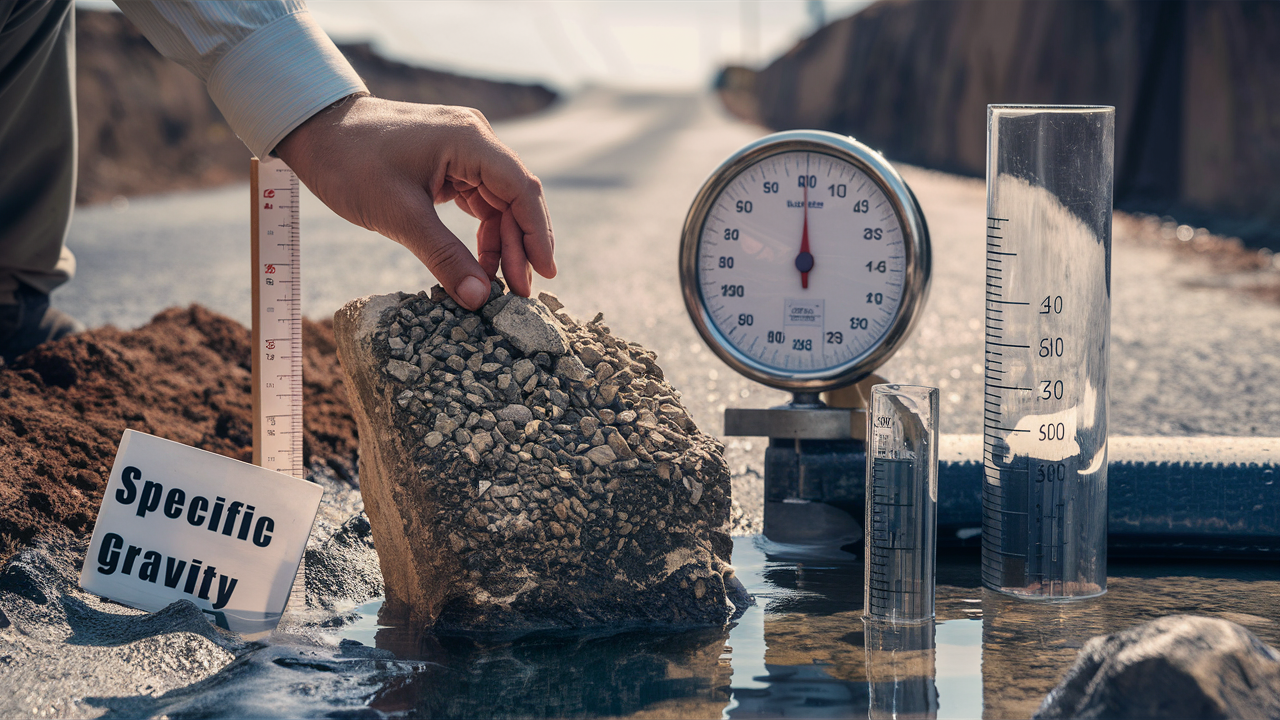Table of Contents
What is Sub-Base Specific Gravity, and Why Does it Matter?
Sub-base specific gravity measures the density of materials used beneath road surfaces compared to water, including various particle sizes.
This metric is crucial because it helps predict how well the subbase will support and maintain the road’s structural integrity, ensuring durability and safety.
Common Sub-Base Materials and Their Specific Gravity Ranges
Crushed rock, gravel, and sand——all types of aggregate used in construction—are common materials used for subbase—are common materials used for subbase.
These subbase materials comprise aggregate particles with unique physical properties such as specific gravity, density, and plasticity.
Specific gravity influences the compaction and stability of these materials, with coarse aggregate being a key component.
As specified in Figure 1, the aggregate gradation, including fine and coarse aggregate, is vital to determining its suitability for subbase use.
The gradation is assessed using a sieve analysis to determine particle size distribution, including three different aggregate gradations, such as 4.75 mm and 37.5 mm fractions. Granular subbase materials are often mechanically compacted to achieve maximum dry density.
Crushed rock has a significantly higher specific gravity, which makes it a preferred choice for its resilient modulus and stability.
Superpave mixture design involves evaluating aggregate sources to recommend appropriate aggregate gradations. This process considers volumetric properties, voids, and nominal maximum aggregate size.
The Impact of Sub-Base Specific Gravity on Pavement Performance

The specific gravity of subbase materials directly influences pavement performance, affecting its ability to withstand traffic loadings and environmental stresses.
Subbase materials, such as aggregate base and base course, must be properly graded. This involves calculating the mix design and considering unit weight, proportion, and the optimum moisture content.
Proper gradation, including fine and coarse aggregates, is crucial for adequate compaction and preventing harmful effects in pavement design.
Aggregate gradation is vital in maintaining stability under load when designing pavement. The Superpave method recommends a mixture design that ensures durability by considering hydraulic properties and specific gravity.
Laboratory tests are conducted to evaluate compressive strength, unit volume, resilient modulus, and mix properties, including the maximum specific gravity of the subbase material.
Parameters like the amount of water, plasticity index, and aggregate size distribution are vital indicators. Laboratory using quarry-sourced aggregate helps determine appropriate gradation.
Compaction and Hydraulic Properties of Sub-Base Materials
Compaction must achieve maximum dry density using appropriate mix proportions to ensure the pavement remains functional.
Base and subbase materials undergo rigorous laboratory tests involving aggregate gradation, unit weight, and optimum moisture content. Base materials should also be porous enough to allow hydraulic movement.
A void structure that prevents water saturation while maintaining stability is essential. Compaction using Superpave techniques optimizes the aggregate mix design, considering the nominal maximum size and volumetric properties.
Aggregate sources, whether recycled or freshly quarried, are evaluated to achieve a suitable aggregate base.
Proper compaction and materials like 30 percent fine aggregate ensure adequate support for subsequent pavement layers.
Factors like compressive strength, the amount of water added, and index properties contribute to achieving the best soil stabilization results, ultimately improving the durability of the paved surface.
How to Determine the Specific Gravity of Sub-Base Material
To determine the specific gravity, samples of the sub-base material are dried and weighed to ensure they do not saturate. They are submerged in water, and their wet weight is measured to determine the specific gravity of the fine aggregate.
The difference in weights helps calculate the specific gravity, which indicates how the material’s particle size will perform under pressure. See You More Sub-Base Specific Gravity.
Meeting Project Specifications with Sub-Base Specific Gravity

Ensuring that sub-base materials meet specific gravity specifications is vital for compliance with engineering standards and project durability, especially considering particle sizes.
Accurate measurements help engineers choose the suitable materials to meet the project’s demands, reducing the risk of structural failure.
The Consequences of Ignoring Sub-Base Specific Gravity
Not paying attention to the weight of materials used under roads in building projects can cause big problems. If suitable materials are used, they will support the road well.
This can make the road break down quickly, showing cracks, ruts, and uneven surfaces. These problems can make the road unsafe for people driving and walking.
Ignoring this can lead to expensive fixes, more upkeep, and a shorter life for the road due to improper gradation of marginal materials. So, it’s essential for building teams to check and follow the proper guidelines for these materials to keep roads safe and lasting longer.
Benefits of Using Sub-Base Material with Optimal Specific Gravity
Using suitable materials under roads is very helpful. When these materials have the right weight and gradation, they make a strong base for the asphalt layer.
This base helps spread the weight from cars, preventing the road from getting damaged easily. Thus, it enhances pavement design. This means the road will last longer and won’t need as much fixing. Also, using the correct materials makes the road work better.
It provides a smoother ride and better withstands weather changes and water. By choosing suitable materials, road projects can save money over time and make safer, better roads for everyone.
Resources for Further Information on Sub-Base Specific Gravity

Many resources exist for ORK pavement construction workers who need more information on sub-base-specific gravity.
Groups like the American Association of State Highway and Transportation Officials (AASHTO) and the Federal Highway Administration (FHWA) provide clear rules and methods for checking sub-base materials.
You can also find helpful tips and best practices in easy-to-read papers, studies, and case reports from trusted schools and organizations focusing on aggregate gradation. Talking to seasoned engineers, soil experts, and materials suppliers can give practical advice and help tailored to your project needs.
By using these resources, builders can better understand sub-base-specific gravity and make intelligent choices about aggregate mixtures to ensure the success of their pavement projects.
Case Studies: Examples of Successful Construction with Proper Sub-Base Specific Gravity
Studying case studies of successful projects focusing on the right sub-base specific gravity is very helpful. These studies show projects where careful choices, testing, and using suitable aggregate as sub-base materials have led to solid, long-lasting roads.
Construction teams can learn from past projects involving different aggregate types by looking at the problems faced, solutions used, and results achieved in these cases.
This helps them improve their future projects. These case studies also show the benefits of focusing on sub-base specific gravity, such as better road performance, longer road life, and savings, which are essential for AGC projects.
Using these lessons, construction teams can make better roads that last longer and offer more value to everyone by using quality coarse aggregate.
Final Thoughts
The specific gravity of sub-base materials is critical to how long pavement lasts, as shown in test results highlighting the importance of using quality mineral aggregates.
By understanding this, construction teams can make intelligent choices about the gradation of materials to keep their pavement solid and functional for a long time.
As indicated in Figure 3, focusing on the proper specific gravity for the sub-base improves the road’s performance and lifespan and reduces early damage and costly fixes.
Construction teams can achieve great results with their asphalt mix by following project rules, using resources wisely, and learning from successful projects. This leads to durable, high-quality roads that meet the needs of communities now and in the future.
FAQs:
What is the compaction of the subbase?
Subbase compaction involves compacting the subbase material to achieve a specified density, typically around 95% of maximum density.
What is the thickness of the subbase?
The thickness of the subbase layer varies depending on project requirements but generally ranges from 4 to 12 inches.
What is the density of the subgrade?
The density of the subgrade, or the natural soil beneath the pavement layers, varies based on soil type and compaction effort, typically ranging from 90% to 100% of maximum density.




